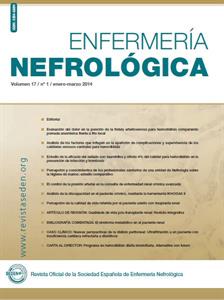Contenido del artículo principal
Resumen
Una de las principales actividades de enfermería nefrológica en las unidades de hemodiálisis, es el cuidado de catéteres venosos centrales mediante el cumplimiento de un protocolo que hace especial hincapié en las medidas universales de asepsia durante su manipulación. Además existen otras variables que pueden infl uir en la aparición de complicaciones del catéter limitando su supervivencia. Objetivo Los objetivos de este estudio fueron analizar los factores que pudieran infl uir en la aparición de complicaciones del catéter venoso central para hemodiálisis, y valorar las tasas de infección en nuestro centro. Material y método Se realizó un estudio descriptivo de una cohorte, en la Unidad de Diálisis del Hospital Meixoeiro, entre enero de 1991 y octubre de 2012, con una muestra formada por 1231 catéteres. Resultados Fueron implantados 1231 catéteres (1187 temporales y 44 tunelizados tipo Hikman). Los temporales, 78% en femoral, 18% en yugular, y 4 % en subclavia. Los Hikman, 40 en lado derecho y 4 en lado izquierdo. La duración media de los catéteres implantados fue de 17,7 ± 30,8 días (mediana 8 días). 88% no presentaron incidencias durante su colocación. Las principales causas de colocación fueron la IRA (56%) y el fallo de acceso vascular previo (30%). La principal complicación dentro de las causas de retirada fue la obstrucción del catéter (15%), siendo la más grave la infección (6%). De los 1231 catéteres, 70 presentaron un episodio de infección a los 19,1±33,0 días de media, (mediana 12 días)
Palabras clave
Detalles del artículo
Aviso de derechos de autor/a
© Los autores ceden de forma no exclusiva los derechos de explotación de los trabajos publicados y consiente en que su uso y distribución se realice con la Licencia Creative Commons Atribución - No comercial 4.0 Internacional (CC BY-NC 4.0). Puede consultar desde aquí la versión informativa y el texto legal de la licencia. Esta circunstancia ha de hacerse constar expresamente de esta forma cuando sea necesario.




